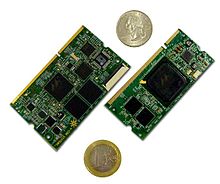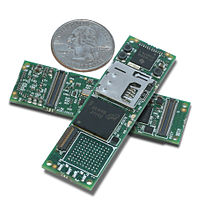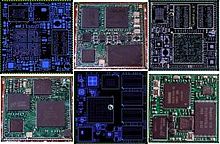- Computer-on-module
-
A computer-on-module (COM) or System on Module (SOM) is a type of single-board computer (SBC), a subtype of an embedded computer system. An extension of the concept of System on Chip (SoC), COM lies between a full-up computer and a microcontroller in nature.
Contents
Design
Today's COM modules are complete embedded computers built on a single circuit board. The design is centered on a microprocessor with RAM, input/output controllers and all other features needed to be a functional computer on the one board. However, unlike a single-board computer, the COM will usually lack the standard connectors for any input/output peripherals to be attached directly to the board.
The module will usually need to be mounted on a carrier board (or "baseboard") which breaks the bus out to standard peripheral connectors. Some COMs also include peripheral connectors and/or can be used without a carrier.
A COM solution offers a dense package computer system for use in small or specialized applications requiring low power consumption or small physical size as is needed in embedded systems. As a COM is very compact and highly integrated, even complex CPUs, including multi-core technology, can be realized on a COM.
Using a carrier board is a benefit in many cases, as it can implement special I/O interfaces, memory devices, connectors or form factors. Separating the design of the carrier board and COM makes design concepts more modular, if needed. A carrier tailored to a special application may involve high design overhead by itself. If the actual processor and main I/O controllers are located on a COM, it is much easier, for example, to upgrade a CPU component to the next generation, without having to redesign a very specialized carrier as well. This can save costs and shorten development times. On the other hand, this only works if the board-to-board connection between the COM and its carrier remains compatible between upgrades.
Some devices also incorporate Field Programmable Gate Array (FPGA) components. FPGA-based functions can be added as IP cores to the COM itself or to the carrier card. Using FPGA IP cores adds to the modularity of a COM concept, because I/O functions can be adapted to special needs without extensive rewiring on the printed circuit board.
History
The terms "Computer-on-Module" and "COM" were coined by VDC Research Group, Inc. (formerly Venture Development Corporation) (Natick, MA, USA) to describe this class of embedded computer boards.
The term became more notable upon industry standardization of the COM Express format.
See also
- CoreExpress
- Embedded System Module
- ESMexpress
- ETX Form Factor
- Qseven
- XTX
External links

This computer hardware article is a stub. You can help Wikipedia by expanding it.



